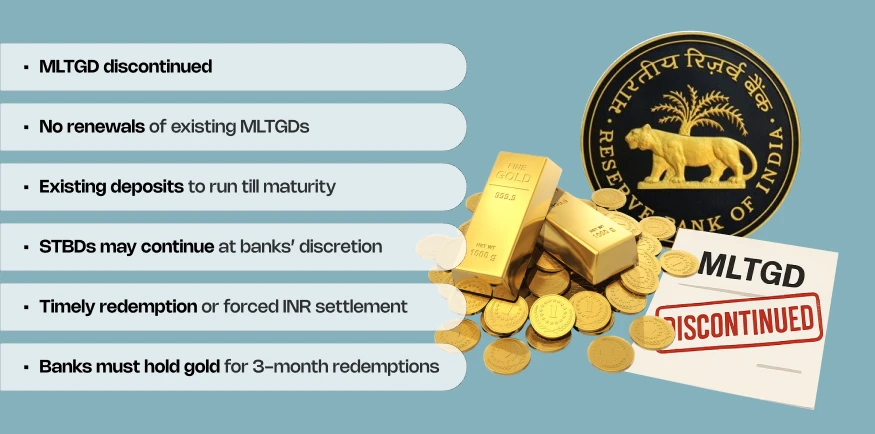The Government of India and the RBI have discontinued the Medium and Long Term Government Deposits (MLTGD) under the Gold Monetization Scheme (GMS), effective March 26, 2025. Going forward, only Short Term Bank Deposits (STBD) may be offered under GMS – at banks’ discretion. This means no new MLTGD accounts can be opened, and existing ones will be serviced till maturity. The move marks a significant shift in India’s gold policy.
Why the Government is Phasing Out Long-Term Gold Deposits
The Gold Monetization Scheme (GMS) was launched in 2015 to bring idle gold lying with households and institutions into the formal economy. The idea was to reduce reliance on gold imports, which strain India’s current account deficit. GMS had three components:
- Short Term Bank Deposits (STBD) – 1 to 3 years
- Medium Term Government Deposits (MTGD) – 5 to 7 years
- Long Term Government Deposits (LTGD) – 12 to 15 years
The STBDs were handled by banks, while MLTGDs were underpinned by the Government of India, effectively using the nation’s gold reserves for broader fiscal purposes. Over the years, however, MLTGDs attracted fewer investors due to long tenures, lower flexibility, and complex logistics.
Fast forward to March 2025, and the government, in coordination with RBI, has reevaluated the structure of the scheme, choosing to discontinue MLTGDs while leaving STBDs to bank discretion.
Key Highlights

- MLTGD Discontinued: No fresh medium or long-term deposits under GMS will be accepted from March 26, 2025.
- No Renewals: Even renewals of existing MLTGD accounts are not allowed post-March 25, 2025.
- Existing MLTGDs Intact: Deposits made until March 25, 2025, will continue under current guidelines until maturity.
- STBDs May Continue: Banks may offer STBDs under GMS, but it is not mandatory.
- Regulatory Update: RBI has amended the Master Directions on GMS to reflect these changes.
- FAQs Being Updated: RBI will also update the Frequently Asked Questions to incorporate new policy changes.
- Operational Clarity: Existing gold accounts will be credited only if the CPTC/GMCTA receipt is dated on or before March 25, 2025.
- Redemption Rules Tightened: Depositors must redeem gold deposits on time or face forced INR settlement.
- Banks Must Maintain Adequate Gold Stock: For redemptions due within 3 months, banks must hold an equivalent amount of physical gold.
- All Provisions in Effect from March 26, 2025: This includes the changes in deposit acceptance, renewals, and redemption protocols.
You can think of MLTGDs like long-term FDs, but in gold instead of cash. With this change, the government is saying: “We’ll no longer offer 10- or 15-year gold FDs. You can only go with short-term ones, and even that depends on the bank you’re dealing with.”
Why This Matters Now
The move aligns with broader goals: simplifying public investment in gold, minimising administrative burden on banks, and keeping pace with global monetary trends. India’s gold reserves and household holdings are massive, but monetising them effectively has always been a challenge.
By dropping the MLTGD components, the government appears to be focusing more on short-term instruments that offer better liquidity and operational efficiency. For fintechs and banks, this is a cue to innovate with STBDs and explore new digital gold frameworks.
Impact on Fintechs
1. No More MLTGD Products
Startups dealing in wealth-tech, gold investment platforms, or banking APIs integrating GMS products must immediately remove MLTGD options from their offerings.
2. Audit Existing MLTGD Customers
Ensure your platforms don’t allow renewals or fresh applications for MLTGD post-March 25, 2025. If you’re maintaining a digital ledger or gold account linked to banks, ensure these reflect the cutoff date and block further MLTGD flows.
3. Update Communication
Inform users about the discontinuation of MLTGD. This is especially important for platforms offering gold savings or locker-linked products.
4. STBD as an Alternative
If you’re building or partnering with banks for gold-linked savings products, check whether STBDs are still available with your partner banks. You might consider repositioning your product features accordingly.
5. KYC and Customer Experience
The amended guidelines reaffirm the importance of KYC compliance for any gold account. Fintechs must ensure seamless onboarding, especially if offering STBDs.
6. Legal & Compliance Teams
Ensure your legal documentation, T&Cs, and product flows are updated to comply with the new RBI directions. Any discrepancy could lead to regulatory issues.
Broader Market Implications

For Banks:
- No More Government Risk Transfer: With MLTGD gone, banks retain gold risk for STBDs.
- Operational Efficiency: Less complexity in handling long-term government-linked accounts.
- Shift in Liquidity Planning: Banks must reassess how much gold they keep in reserve for redemptions.
For Investors:
- Lower Tenure Options: Only STBDs are likely to be offered, and those too only if banks find them profitable.
- Push Towards Digital Gold: We may see greater innovation around tokenised gold, ETFs, or app-based gold savings plans.
For Government:
- Reduced Fiscal Liability: No obligation to service MLTGD interest or redemptions beyond what’s already booked.
- More Data-Driven Oversight: The updated RBI FAQs and regulatory framework indicate a shift to cleaner, tech-enabled reporting.
Actionable Steps for Fintechs
✅ Cease Offering MLTGD Products Immediately
✅ Update Product Documentation & Terms
✅ Review Contracts with Banks and CPTCs
✅ Communicate Changes to Users Clearly
✅ Focus on STBD Offerings (if applicable)
✅ Keep Tabs on RBI FAQs and Future Clarifications
✅ Prepare Contingency Plans for customers impacted by unavailability of MLTGDs
✅ Explore Alternate Gold Products like Sovereign Gold Bonds or digital gold partnerships
Deadline
- March 25, 2025: Last day for MLTGD acceptance or renewal.
- March 26, 2025: Amended Master Direction comes into force.
Conclusion
The Gold Monetization Scheme shift underlines the government’s evolving stance on managing India’s gold economy. By discontinuing MLTGD, the focus appears to be on more liquid, bank-managed gold deposits. For fintechs, especially those operating in wealth-tech, lending, or digital banking, it’s time to realign product offerings, ensure compliance, and guide users accordingly.
While this may appear as a rollback, it could be an opportunity for fintechs to reimagine short-term gold-linked savings products. Think of it as a chance to simplify offerings, enhance transparency, and strengthen trust in gold-based instruments.
Stay agile, stay compliant, and use this moment to innovate around gold as an asset class.
Need help updating your gold investment flows or bank APIs to align with the new GMS rules?
📩 Talk to a BeFiSc Expert




